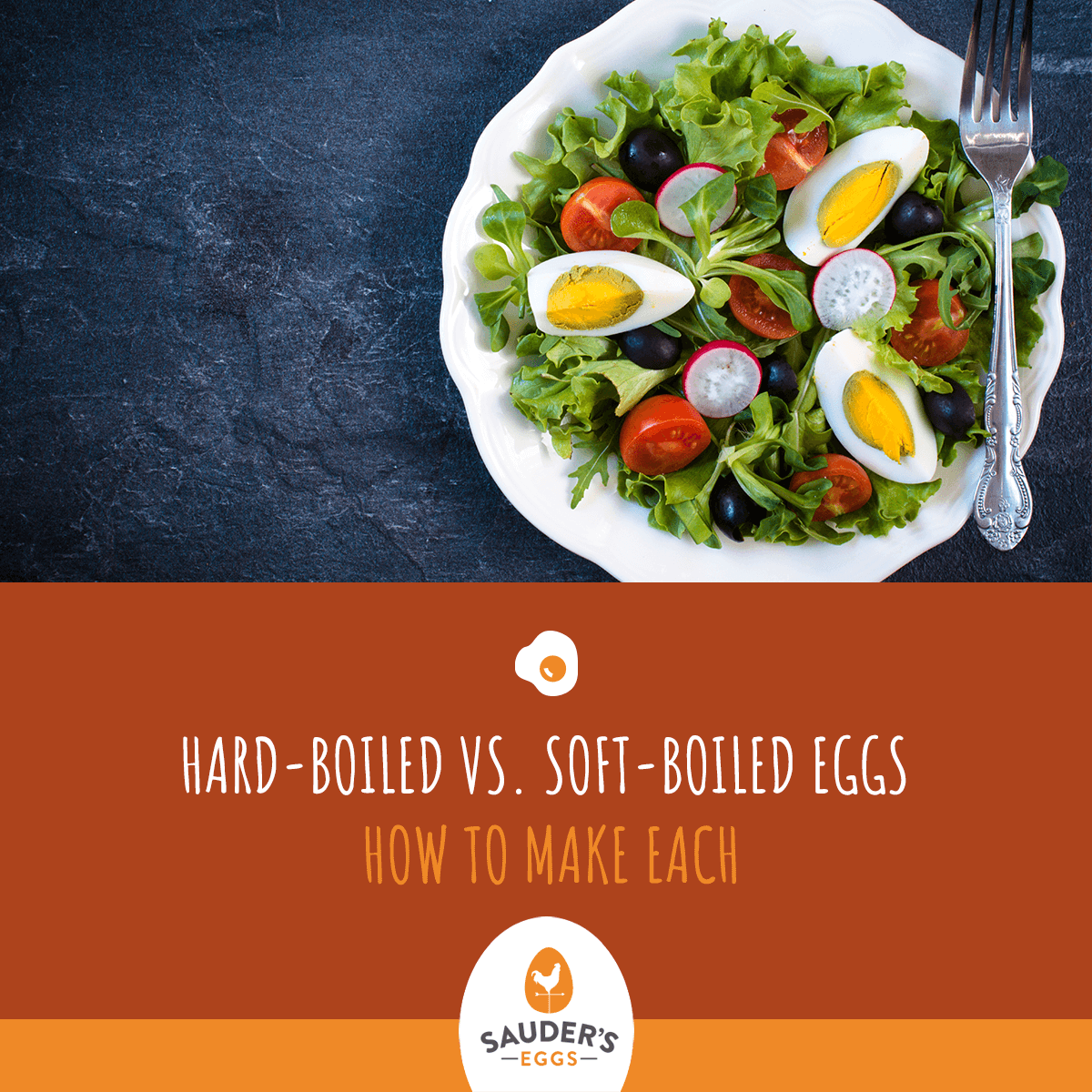Hard-Boiled vs. Soft-Boiled Eggs: How to Make Each
Posted on: February 28th 2023

Eggs are a staple food in many people’s diets. However, eating scrambled and fried eggs all the time can leave you a little bored with your eggs. Boiling eggs is a great way to spice up your diet without losing out on all the excellent nutritional benefits of eggs. Let’s look at the best ways to cook and serve hard-boiled and soft-boiled eggs so you can add another cooking method to your repertoire. We’ll dive into all the details of egg boiling, the difference between hard-boiled and soft-boiled eggs, and how you can add them to your next meal.
What Is a Hard-Boiled Egg?
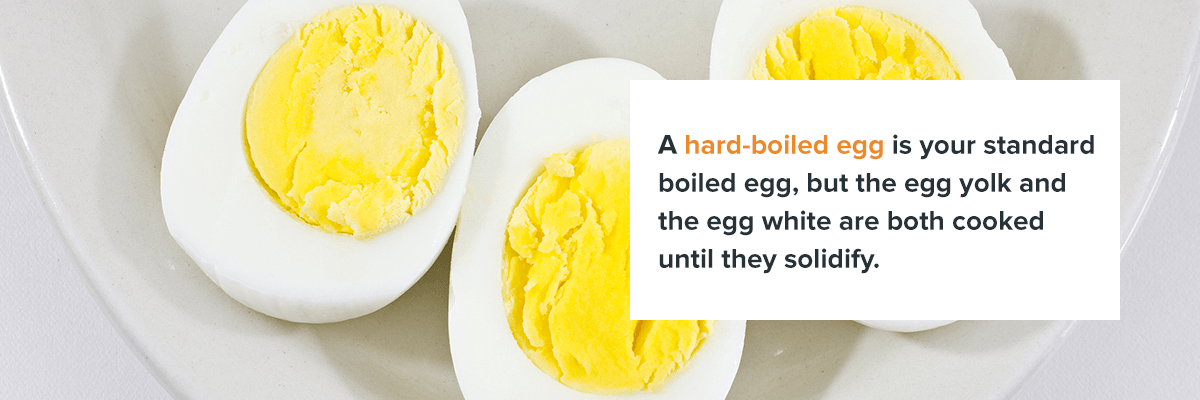
Boiling eggs is a long-standing, popular method for cooking eggs. A hard-boiled egg is your standard boiled egg, but the egg yolk and the egg white are both cooked until they solidify. This leaves you with a firmer, smoother egg that’s easy to transport and add to dishes since you don’t have to worry about the egg yolk breaking and spilling out all over your food. The longer cook time makes hard-boiled eggs excellent for hot or cold eating.
Hard-boiled eggs are considered one of the simplest egg dishes for amateurs, making them perfect for egg chefs of all skill levels. You can throw them in salads, eat them as a side, or even turn them into deviled eggs.
What Is a Soft-Boiled Egg?
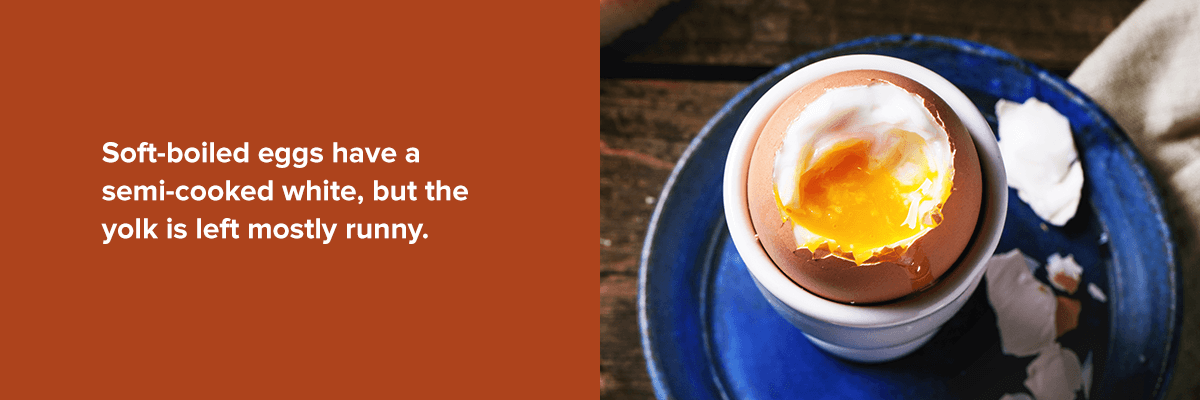
A soft-boiled egg is also boiled, but it’s cooked for less time than a hard-boiled egg. Soft-boiled eggs have a semi-cooked white, but the yolk is left mostly runny. You can customize the exact runniness depending on preference and cooking method.
Soft-boiled eggs are one of the trickier egg recipes to perfect. They’re popular for breakfast and come served in certain soups or as their own side dish.
The Difference Between a Hard-Boiled and Soft-Boiled Egg
The main difference when comparing hard-boiled vs. soft-boiled eggs is how cooked the egg whites and yolks are. Hard-boiled eggs are firmer because the egg is fully cooked so that there’s no runniness. Soft-boiled eggs are only partially-cooked, so they have a runny yolk and a less-firm exterior. The different levels of cooking give them a unique tasting experience.
Which Is Healthier?
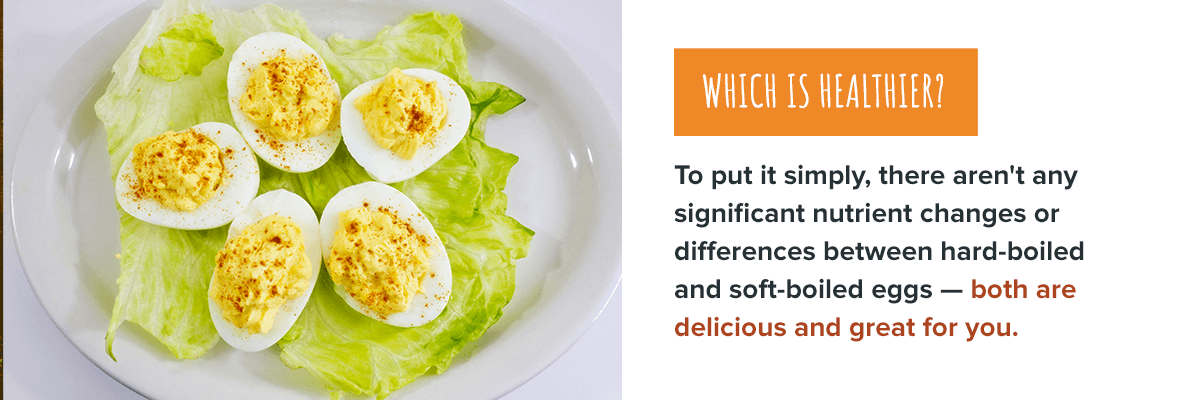
If you’re comparing soft-boiled eggs vs. hard-boiled eggs, nutrition might be an essential component for you. No vitamin or mineral denaturation occurs when cooking a hard-boiled or soft-boiled egg. To put it simply, there aren’t any significant nutrient changes or differences between hard-boiled and soft-boiled eggs — both are delicious and great for you.
However, there could be some potential health concerns surrounding soft-boiled eggs. Like all eggs, there’s a risk of salmonella. Whether your eggs are uncracked or soft-boiled, there might be traces of illness-causing bacteria in and on the egg. That’s why you should always store, wash and serve your eggs safely. Soft-boiled eggs pose a higher risk of salmonella than hard-boiled eggs since the yolk is left runny when you eat it.
Anyone with weakened immune systems or certain health conditions may want to avoid soft-boiled eggs, or eggs in general, due to higher risk. Anyone older than 65, younger than five, immunocompromised, or pregnant has a higher risk of food poisoning. If one of these applies to you, you could be more likely to get salmonella from eating runny, undercooked or raw eggs, like soft-boiled eggs.
Eggs are a great healthy food option for almost everyone. They’re rich in protein and identified as a nutrient-dense food, full of essential vitamins and minerals that fuel our bodies. Eggs are also a primary source of choline for Americans. Choline is a nutrient that helps with cell signaling, neuronal development, and metabolism. Overall, eggs in most forms can help you build a healthier, happier lifestyle.
How to Hard-Boil Eggs
If you’re looking for an easy, versatile egg to make whenever you need to meet your protein and nutrient goals for the day, look no further than hard-boiled eggs. Let’s break down hard-boiled eggs so you can cook yours perfectly every time.
To cook hard-boiled eggs, you’ll need:
- Several eggs
- A pot with a lid
- Cold water
- A strainer
Once you’ve got everything together, you’re ready to start cooking. Here’s how to cook hard-boiled eggs:
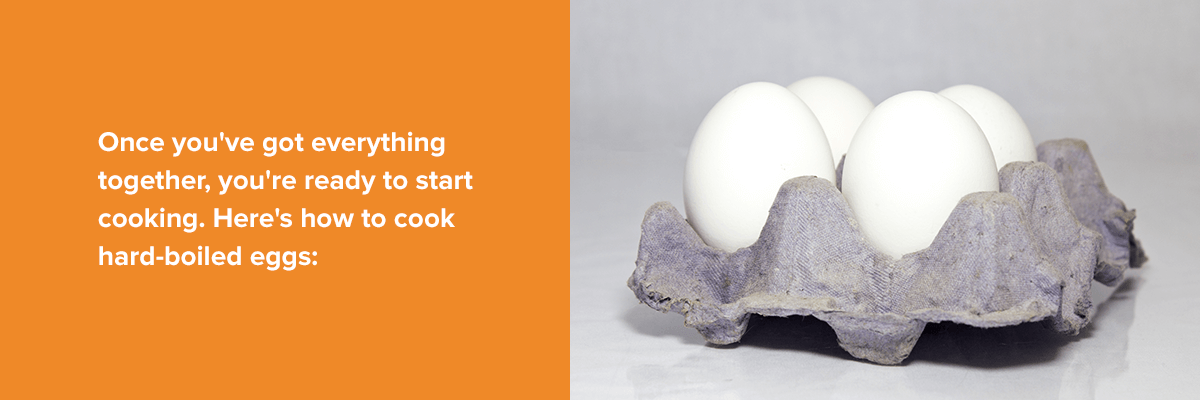
Step 1
Place your pot on the stove burner. Don’t turn the burner on just yet. Next, carefully place your eggs in the pot and cover them with cold water. Make sure to fill the pot with enough water to cover the eggs. The water should be around an inch higher than the eggs.
Step 2
Once everything is in the pot, it’s time to turn the burner on. Set the burner to high heat and put the lid on to cover. Bring the water to a boil.
Step 3
When your water begins boiling, it’s time to turn the heat off. Leave the eggs on the stove with the heat off and the lid on. Let them sit for 10 to 12 minutes. The longer you leave the eggs, the firmer they’ll get, so you may have to experiment to find the best firmness for you. Additionally, you’ll want to cook the eggs for fewer than 10 minutes if they are smaller and a little longer if they are larger.
Step 4
Once the eggs are done, take the pot and drain the eggs into a strainer over your sink. After draining all the hot water, rinse the eggs with cold water until they’re cool.
Step 5
To peel your hard-boiled eggs, lightly tap the egg on the counter on all sides. Then, gently roll the egg between your hands to get the shell nice and loose. Next, start peeling the egg from the largest end. It might be more difficult if your eggs are freshly boiled, but just keep peeling, and you’ll get it.
Step 6
Enjoy your delicious hard-boiled egg with salt, or incorporate it into another dish you’ve got ready.
Top Tips for Hard-Boiled Eggs
Here are some cooking tips and tricks to help you get the best hard-boiled egg possible. You’ll want to try these out and refine them, so you always cook your favorite version of hard-boiled eggs when you want them.
- Add salt: Adding salt to your water is one way to help your eggs turn out better. The salt in the water will help with egg flavor since the eggs will absorb some of the salt while cooking. Additionally, some people swear by salt for easier egg peeling. You’ll have savory, tasty eggs as soon as they’re done cooking when you add a little salt.
- Add vinegar: Sometimes, an egg cracks in the pot, sending egg whites everywhere. Add a teaspoon of vinegar to your pot to help prevent any whites from spreading. If any eggs crack, the vinegar will help the egg hold its shape while cooking.
- Only boil a few eggs at a time: Never add more than six eggs to your pot at once. While this might seem more time-consuming, you’ll get overall better eggs. Too many eggs in the pot at a time can throw off cooking times, meaning boiling will take longer than you expect. Keep each pot to six or fewer eggs for the best results.
- Leave them in the fridge: Older eggs are easier to peel. If you want the fastest peel time, leave your eggs in the fridge for at least a couple of hours after boiling them. The longer they sit, the quicker the shells will come off.
If you want to elevate your hard-boiled eggs, try bringing them to a boil in 6 quarts of water and then reducing them to a simmer on low for 11 minutes. Afterward, leave the eggs in an ice bath for 15 minutes. You’ll find that the hot-to-cold water system makes the eggs perfectly cooked and easier to peel. This method is much more time and labor-intensive than the simple method mentioned above, but if you want to refine your hard-boiled eggs, this is the way to do it.
What a Perfect Hard-Boiled Egg Looks Like
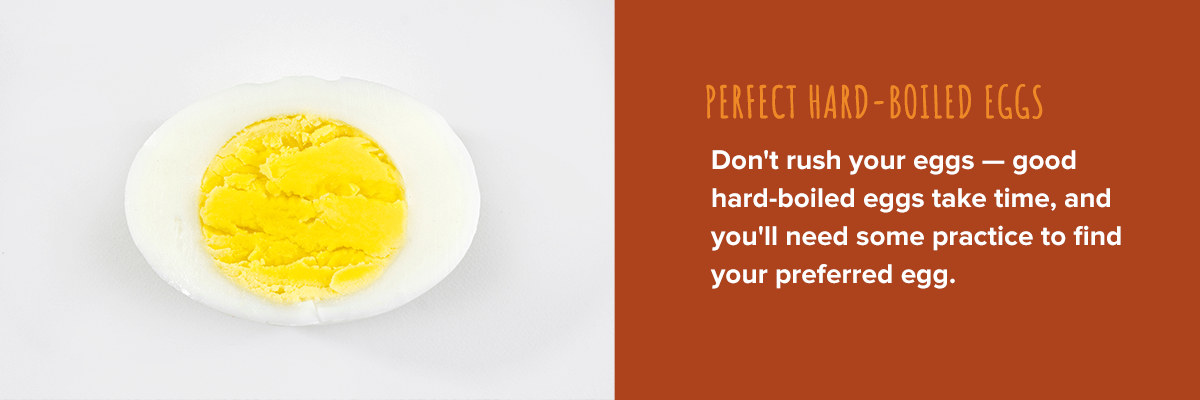
All eggs are subjective, but the perfect hard-boiled egg will be mostly cooked through with the yolks set. You might prefer a slightly less firm egg or a really firm yolk. Whatever your preference, the key to the perfect hard-boiled egg is time. Don’t rush your eggs — good hard-boiled eggs take time, and you’ll need some practice to find your preferred egg.
A good hard-boiled egg has a bright, firm white outside. It may be slippery or rubbery in texture. The yolk, regardless of firmness, should be golden-yellow. The more firm the yolk is, the paler yellow it will be. A fully-set, firm hard-boiled egg will have a lighter yellow yolk, while less-firm yolks will seem slightly translucent and more pigmented.
How to Soft-Boil Eggs
Cooking soft-boiled eggs is similar to cooking hard-boiled eggs but is a little trickier to get right. If you cook them too long, you’ll miss out on the runny center that makes these eggs so good. Since there’s less room for error, you should try cooking soft-boiled eggs a few times to get the hang of it. The soft-boiling method is slightly more advanced than standard hard-boiled eggs, so don’t get discouraged if you overcook them the first few times.
The tools you need for cooking soft-boiled eggs are similar to hard-boiled eggs. Make sure to have these items before starting:
- A pot with a lid
- Several eggs
- A strainer
- A slotted spoon
Once you’ve got everything together, it’s time to start cooking. Here’s how to make delicious soft-boiled eggs:
Step 1
Fill your pot or saucepan with water. You’ll want to ensure that you have enough water to cover the eggs by at least an inch, but it’s fine if there’s more water than that once you put the eggs in. Bring the water to a boil on high heat without putting the eggs in.
Step 2
Once the water is boiling, bring the heat down to medium-high. Then, gently lower your eggs into the pot with your slotted spoon, being careful not to splash water or break the eggs. Put the lid on the pot and adjust the heat as necessary to keep the water from over-boiling.
Step 3
Leave the eggs cooking for six minutes. If you have smaller eggs, do five minutes and if you have larger eggs, try seven. The longer they cook, the closer to hard-boiled they’ll get, but you don’t want to have undercooked whites.
Step 4
After six minutes, turn off the heat and strain your eggs into a strainer in the sink. Run cold water over them until they’ve cooled off. You can also leave them in a bowl of ice water for two minutes if you don’t want to use the sink.
Step 5
Your eggs should now be slightly warm. You can gently crack them all over their surface and peel them. Once they’re peeled, serve and enjoy.
Top Tips for Soft-Boiled Eggs
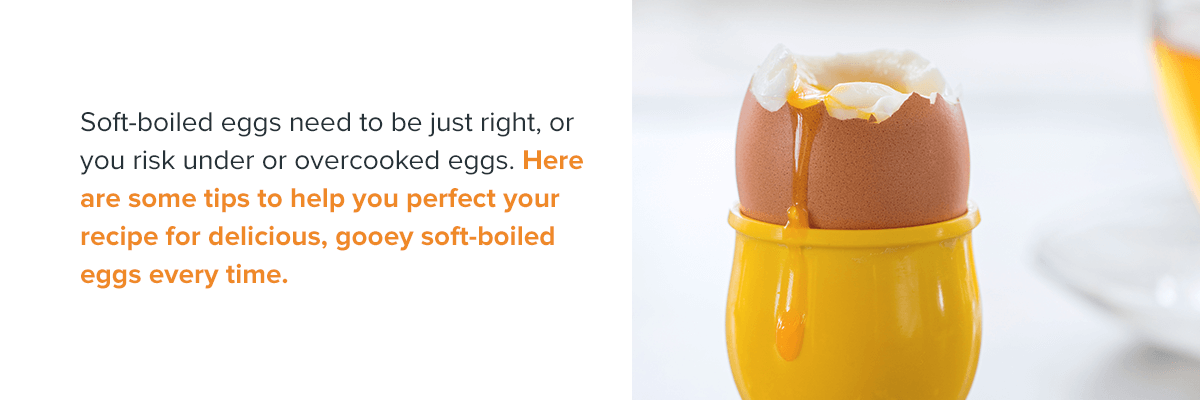
Soft-boiled eggs need to be just right, or you risk under or overcooked eggs. Here are some tips to help you perfect your recipe for delicious, gooey soft-boiled eggs every time.
- Boil water first: Always boil your water before putting your eggs in. With soft-boiled eggs, it’s essential to get the timing right so you don’t overcook the yolk. If you put the eggs in the water and start the heat, your eggs will begin cooking as the water warms, throwing off your timing.
- Use cold eggs: Use eggs straight from the fridge when making soft-boiled eggs. If your eggs are sitting on the counter becoming room temperature, there’s a higher risk of bacteria, and the warmer egg could mess with your cooking time. An already-warm egg will cook faster than a cold one.
- Cook a few at a time: Like hard-boiled eggs, never put more than six eggs in the pot at a time. You want everything to cook evenly and fully during your six minutes. The more eggs, the more room for error with cook time.
What a Perfect Soft-Boiled Egg Looks Like
Your perfect soft-boiled egg will look different depending on your preferences. Test out a few different cooking times to get a feel for the kind of soft-boiled egg you like best. Let’s go over what your soft-boiled egg should look like depending on how long you cook it.
If you like a runnier egg with an egg white that’s not fully set, you should cook your eggs for around five minutes. That will give you a mostly-cooked egg with a loose yolk and an egg white that’s not completely firm. For a just-right soft-boiled egg with a set egg white and a slightly runny yolk, cook six minutes. Finally, cook for seven minutes if you want an egg yolk with a jelly-like texture. This will set your egg enough to not be runny, but won’t turn it into a hard-boiled egg.
Have fun with your boiled eggs — experiment with different cook times and try your eggs runny, jelly-like and firm. You might be surprised at how much you enjoy a particular texture, and the more you boil eggs, the better you’ll get at making them.
The Best Recipes for Hard-Boiled Eggs
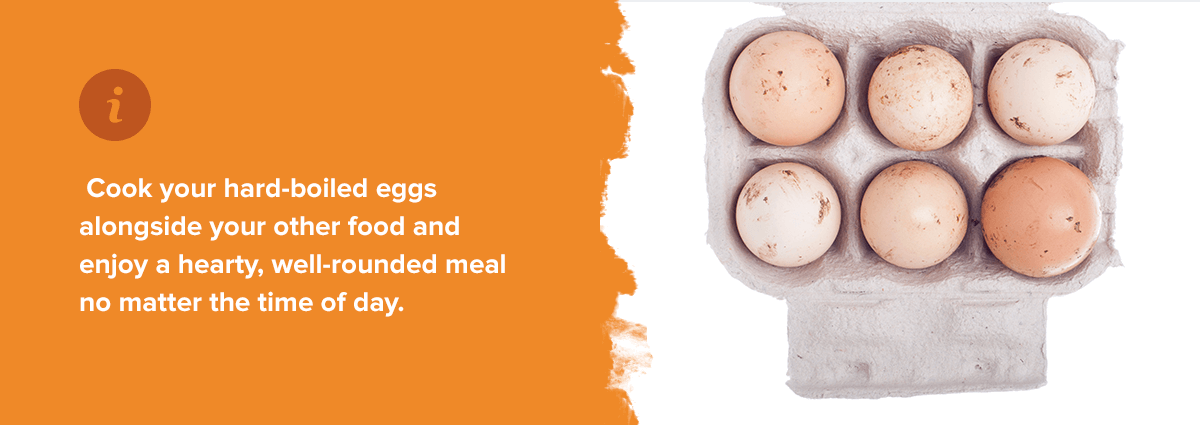
Hard-boiled eggs are a top-notch addition to any recipe. They add a new texture to your dish and are popular for their health benefits and taste. Cook your hard-boiled eggs alongside your other food and enjoy a hearty, well-rounded meal no matter the time of day. Here are a few hard-boiled egg recipe ideas to help you get started.
Breakfast
Hard-boiled eggs are the perfect way to start your day. Enjoy two hard-boiled eggs on their own for breakfast for a quick, easy meal. Additionally, you can slice them up and throw them into your favorite breakfast sandwich for a satisfying meal.
Turn your hard-boiled eggs into scrumptious deviled eggs and eat them for breakfast, snacks, and appetizers. Pair your deviled eggs with relish, jalapeños, or paprika for an extra flavor explosion. Serve them for parties and meals and enjoy easy protein-filled finger food.
Lunch and Dinner
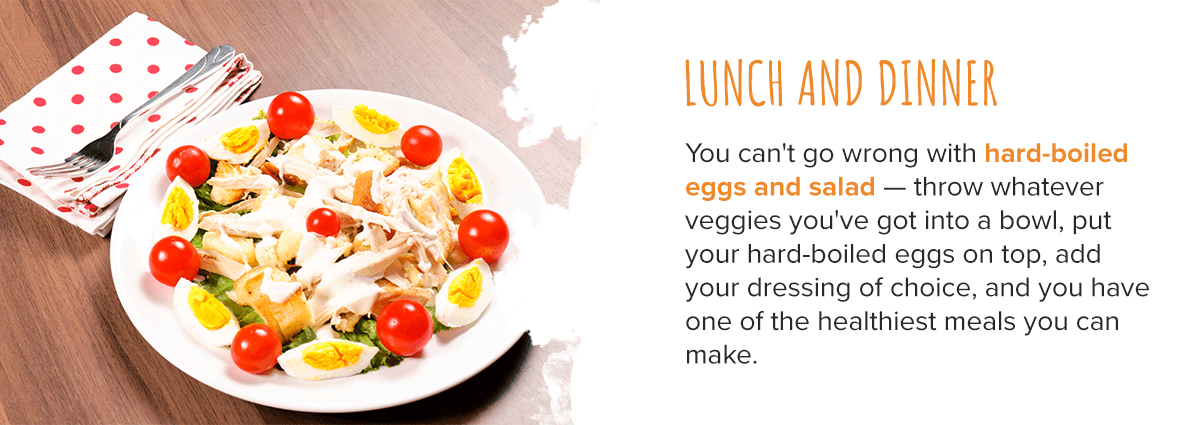
There are dozen of potential meals you can add hard-boiled eggs to. Make a healthy summer salad with delicious greens, tomatoes, onions, croutons, and hard-boiled eggs. You can’t go wrong with hard-boiled eggs and salad — throw whatever veggies you’ve got into a bowl, put your hard-boiled eggs on top, add your dressing of choice, and you have one of the healthiest meals you can make.
Grandma’s egg salad is a classic use of hard-boiled eggs. Whether you eat your egg salad with a spoon or throw it onto a sandwich with some lettuce, this is a tried-and-true hard-boiled egg recipe.
Speaking of salads, hard-boiled eggs go great in vegetarian pasta salads. Dice them up and mix them in well with your pasta, dressing, and veggies. You’ll have a savory pasta dish that tastes delicious and fuels your body all day.
The Best Recipes for Soft-Boiled Eggs
Here are some delicious recipes you can use to serve your soft-boiled eggs. Incorporate soft-boiled eggs into your regular meals for a tasty, easy way to get protein and vital nutrients into your body.
Breakfast
Soft-boiled eggs for breakfast and snack time are a simple affair. In England, it’s common to eat two soft-boiled eggs for breakfast with a side of toast. Use a knife to take the top of your eggshell off and dip your spoon or some toast inside to eat with your egg. The gooey egg yolk pairs well with toast, and you can add a little butter for some extra savory flavor.
Another mouthwatering breakfast dish you can pair soft-boiled eggs with is avocado toast. Once your toast and avocado are prepared, cut your soft-boiled egg in half and throw some everything bagel seasoning on top. Enjoy a healthy, filling breakfast that takes no time and little prep.
Lunch and Dinner
Lunch and dinner are where you really get to get creative with your eggs. Soft-boiled eggs are a great addition to any meal as a side or as a staple protein. Make yourself a salad with all sorts of bright, fresh greens and throw your favorite soft-boiled eggs on top.
Another excellent meal idea for soft-boiled eggs is a vegetarian buddha bowl. The sweet potatoes, tahini, avocado, quinoa, and egg all complement each other beautifully. This vibrant bowl is packed with essential nutrients and is perfect for adding healthy variety to your diet.
Enjoy Delicious Eggs From Sauder’s Eggs

If you’re looking to make your own hard-boiled or soft-boiled eggs at home, Sauder’s Eggs has the high-quality and premium eggs you need to get your recipe to turn out just right. Our eggs arrive fresh from family farms, treated with unmatched quality and care. You can trust that you’re getting eggs from reputable, caring farms when you buy from Sauder’s Eggs.
Looking to eat hard-boiled eggs right now but don’t want to make them yourself? Sauder’s Eggs has you covered. Try our buffalo-style, beet, and regular hard-boiled eggs for a perfectly-cooked, mouthwatering egg every time.
Sauder’s Eggs has cage-free, organic, pasture-raised, free-range, and traditional eggs for all your egg recipes. Use our store locator to find delicious, fresh Sauder’s eggs near you today.
